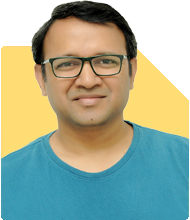55 and Wanting to Retire: Achieve a Rs. 2 Lakh Monthly Income with Rs. 5 Crore+!
Milind Vadjikar | Answer |Ask -Follow
Insurance, Stocks, MF, PF Expert - Answered on Oct 14, 2024
He has a mechanical engineering degree from Government Engineering College, Sambhajinagar, and an MBA in international business from the Symbiosis Institute of Business Management, Pune.
With over 16 years of experience in stock investments, and over six year experience in investment guidance and support, he believes that balanced asset allocation and goal-focused disciplined investing is the key to achieving investor goals.... more

I am 55 and want to retire. I have Rs. 100 lacs in EPF, Rs. 35 lacs in PPF, Rs. 35 lacs in NSC, Rs. 45 lacs in NPS, Rs. 55 lacs in MF, Rs. 50 lacs in FD, Rs. 10 lacs in LIC, Rs. 30 lacs in superannuation fund, Rs. 55 lacs in business, Rs. 110 lacs in housing property (2 flats). What investment planning I should do to get monthly income of Rs. 2 lacs? How much corpus I will have at the age of 65 years with proposed investment plan?
Your current total corpus adds upto around 3.7 Cr. (Excluding NPS part of which will get annuitized at 60 age & RE properties).
If you buy an immediate annuity for this corpus you may expect to receive monthly payout of around 2 L(pre-tax) assuming 7% as annuity rate.
I presume you have occupied one flat for self use and other flat is let out on rent.
The rental income per month from one flat and annuity from balance 40% of NPS(after 60 age) will be your surplus income over and above 2 L as envisaged.
You may opt for annual increase in annuity which is a feature offered by some life insurers.
I do not advise retirement corpus to be exposed to equity considering risks involved hence corpus will remain 4 Cr at 65 unless you decide to sell the extra flat or add lumpsum of NPS corpus (60%) to your sum for more annuity income.
Happy Investing!!
You may like to see similar questions and answers below
Ramalingam Kalirajan |10894 Answers |Ask -Follow
Mutual Funds, Financial Planning Expert - Answered on Apr 15, 2024
Ramalingam Kalirajan |10894 Answers |Ask -Follow
Mutual Funds, Financial Planning Expert - Answered on Jul 04, 2024
Nitin Narkhede |113 Answers |Ask -Follow
MF, PF Expert - Answered on Jan 21, 2025
Ramalingam Kalirajan |10894 Answers |Ask -Follow
Mutual Funds, Financial Planning Expert - Answered on Jul 29, 2025
Radheshyam Zanwar |6747 Answers |Ask -Follow
MHT-CET, IIT-JEE, NEET-UG Expert - Answered on Dec 16, 2025
Shalini Singh |181 Answers |Ask -Follow
Dating Coach - Answered on Dec 16, 2025
Patrick Dsouza |1429 Answers |Ask -Follow
CAT, XAT, CMAT, CET Expert - Answered on Dec 16, 2025
Nayagam P P |10858 Answers |Ask -Follow
Career Counsellor - Answered on Dec 16, 2025
Nayagam P P |10858 Answers |Ask -Follow
Career Counsellor - Answered on Dec 16, 2025
Samraat Jadhav |2510 Answers |Ask -Follow
Stock Market Expert - Answered on Dec 16, 2025
Samraat Jadhav |2510 Answers |Ask -Follow
Stock Market Expert - Answered on Dec 16, 2025
Nayagam P P |10858 Answers |Ask -Follow
Career Counsellor - Answered on Dec 16, 2025
Nayagam P P |10858 Answers |Ask -Follow
Career Counsellor - Answered on Dec 16, 2025
Ramalingam Kalirajan |10894 Answers |Ask -Follow
Mutual Funds, Financial Planning Expert - Answered on Dec 16, 2025



























